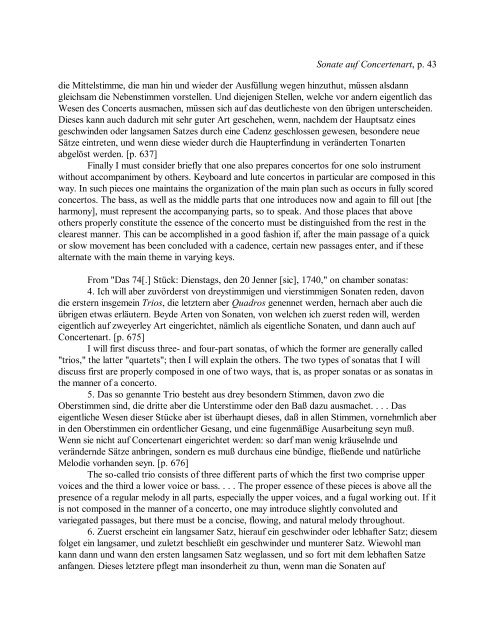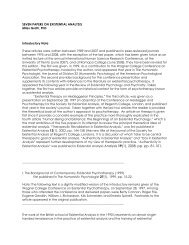The Sonate auf Concertenart: A Postmodern Invention? David ...
The Sonate auf Concertenart: A Postmodern Invention? David ...
The Sonate auf Concertenart: A Postmodern Invention? David ...
You also want an ePaper? Increase the reach of your titles
YUMPU automatically turns print PDFs into web optimized ePapers that Google loves.
<strong>Sonate</strong> <strong>auf</strong> <strong>Concertenart</strong>, p. 43<br />
die Mittelstimme, die man hin und wieder der Ausfüllung wegen hinzuthut, müssen alsdann<br />
gleichsam die Nebenstimmen vorstellen. Und diejenigen Stellen, welche vor andern eigentlich das<br />
Wesen des Concerts ausmachen, müssen sich <strong>auf</strong> das deutlicheste von den übrigen unterscheiden.<br />
Dieses kann auch dadurch mit sehr guter Art geschehen, wenn, nachdem der Hauptsatz eines<br />
geschwinden oder langsamen Satzes durch eine Cadenz geschlossen gewesen, besondere neue<br />
Sätze eintreten, und wenn diese wieder durch die Haupterfindung in veränderten Tonarten<br />
abgelöst werden. [p. 637]<br />
Finally I must consider briefly that one also prepares concertos for one solo instrument<br />
without accompaniment by others. Keyboard and lute concertos in particular are composed in this<br />
way. In such pieces one maintains the organization of the main plan such as occurs in fully scored<br />
concertos. <strong>The</strong> bass, as well as the middle parts that one introduces now and again to fill out [the<br />
harmony], must represent the accompanying parts, so to speak. And those places that above<br />
others properly constitute the essence of the concerto must be distinguished from the rest in the<br />
clearest manner. This can be accomplished in a good fashion if, after the main passage of a quick<br />
or slow movement has been concluded with a cadence, certain new passages enter, and if these<br />
alternate with the main theme in varying keys.<br />
From "Das 74[.] Stück: Dienstags, den 20 Jenner [sic], 1740," on chamber sonatas:<br />
4. Ich will aber zuvörderst von dreystimmigen und vierstimmigen <strong>Sonate</strong>n reden, davon<br />
die erstern insgemein Trios, die letztern aber Quadros genennet werden, hernach aber auch die<br />
übrigen etwas erläutern. Beyde Arten von <strong>Sonate</strong>n, von welchen ich zuerst reden will, werden<br />
eigentlich <strong>auf</strong> zweyerley Art eingerichtet, nämlich als eigentliche <strong>Sonate</strong>n, und dann auch <strong>auf</strong><br />
<strong>Concertenart</strong>. [p. 675]<br />
I will first discuss three- and four-part sonatas, of which the former are generally called<br />
"trios," the latter "quartets"; then I will explain the others. <strong>The</strong> two types of sonatas that I will<br />
discuss first are properly composed in one of two ways, that is, as proper sonatas or as sonatas in<br />
the manner of a concerto.<br />
5. Das so genannte Trio besteht aus drey besondern Stimmen, davon zwo die<br />
Oberstimmen sind, die dritte aber die Unterstimme oder den Baß dazu ausmachet. . . . Das<br />
eigentliche Wesen dieser Stücke aber ist überhaupt dieses, daß in allen Stimmen, vornehmlich aber<br />
in den Oberstimmen ein ordentlicher Gesang, und eine fugenmäßige Ausarbeitung seyn muß.<br />
Wenn sie nicht <strong>auf</strong> <strong>Concertenart</strong> eingerichtet werden: so darf man wenig kräuselnde und<br />
verändernde Sätze anbringen, sondern es muß durchaus eine bündige, fließende und natürliche<br />
Melodie vorhanden seyn. [p. 676]<br />
<strong>The</strong> so-called trio consists of three different parts of which the first two comprise upper<br />
voices and the third a lower voice or bass. . . . <strong>The</strong> proper essence of these pieces is above all the<br />
presence of a regular melody in all parts, especially the upper voices, and a fugal working out. If it<br />
is not composed in the manner of a concerto, one may introduce slightly convoluted and<br />
variegated passages, but there must be a concise, flowing, and natural melody throughout.<br />
6. Zuerst erscheint ein langsamer Satz, hier<strong>auf</strong> ein geschwinder oder lebhafter Satz; diesem<br />
folget ein langsamer, und zuletzt beschließt ein geschwinder und munterer Satz. Wiewohl man<br />
kann dann und wann den ersten langsamen Satz weglassen, und so fort mit dem lebhaften Satze<br />
anfangen. Dieses letztere pflegt man insonderheit zu thun, wenn man die <strong>Sonate</strong>n <strong>auf</strong>















